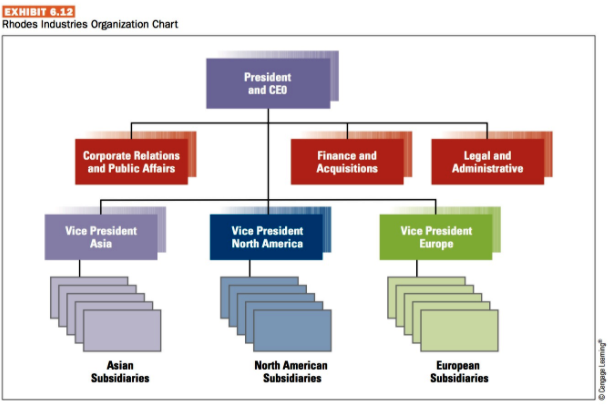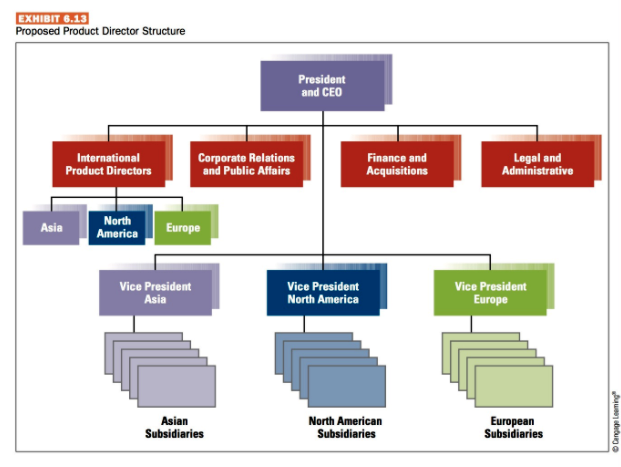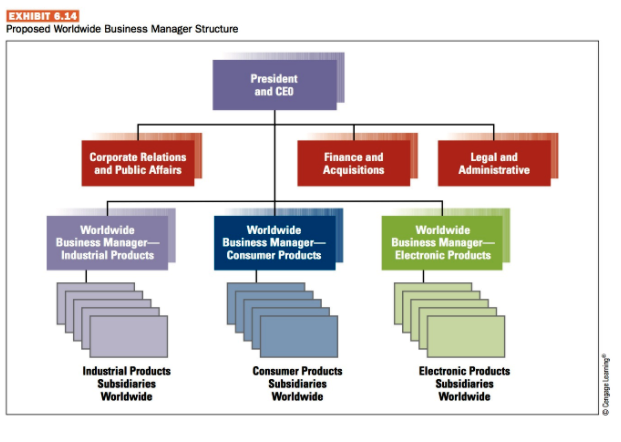Question
David Javier was reviewing the consulting firm?s proposed changes in organization structure for Rhodes Industries (RI). As Javier read the report, he wondered whether the
David Javier was reviewing the consulting firm?s proposed changes in organization structure for Rhodes Industries (RI). As Javier read the report, he wondered whether the changes recommended by the consultants would do more harm than good for RI. Javier had been president of RI for 18 months, and he was keenly aware of the organizational and coordination problems that needed to be corrected in order for RI to improve profits and growth in its interna- tional businesses. Company Background Rhodes Industries was started in the 1950s in Southern Ontario, Canada, by Robert Rhodes, an engineer who was an entrepreneur at heart. He started the business by first making pipe and then glass for industrial uses. As soon as the initial business was established, however, he quickly branched into new areas such as industrial sealants, coat- ings, and cleaners, and even into manufacturing mufflers and parts for the trucking industry. Much of this expan- sion occurred by acquiring small firms in Canada and the United States during the 1960s. RI had a conglomerate- type structure with rather diverse subsidiaries scattered around North America, all reporting directly to the On- tario headquarters. Each subsidiary was a complete local business and was allowed to operate independently so long as it contributed profits to RI. During the 1970s and 1980s, the president at the time, Clifford Michaels, brought a strong international focus to RI. His strategy was to acquire small companies worldwide with the belief that they could be formed into a cohesive unit that would bring RI synergies and profits through low cost of manufacturing and by serving businesses in inter- national markets. Some of RI?s businesses were acquired David Javier was reviewing the consulting firm?s proposed changes in organization structure for Rhodes Industries (RI). As Javier read the report, he wondered whether the changes recommended by the consultants would do more harm than good for RI. Javier had been president of RI for 18 months, and he was keenly aware of the organizational and coordination problems that needed to be corrected in order for RI to improve profits and growth in its interna- tional businesses. Company Background Rhodes Industries was started in the 1950s in Southern Ontario, Canada, by Robert Rhodes, an engineer who was an entrepreneur at heart. He started the business by first making pipe and then glass for industrial uses. As soon as the initial business was established, however, he quickly branched into new areas such as industrial sealants, coat- ings, and cleaners, and even into manufacturing mufflers and parts for the trucking industry. Much of this expan- sion occurred by acquiring small firms in Canada and the United States during the 1960s. RI had a conglomerate- type structure with rather diverse subsidiaries scattered around North America, all reporting directly to the On- tario headquarters. Each subsidiary was a complete local business and was allowed to operate independently so long as it contributed profits to RI. During the 1970s and 1980s, the president at the time, Clifford Michaels, brought a strong international focus to RI. His strategy was to acquire small companies worldwide with the belief that they could be formed into a cohesive unit that would bring RI synergies and profits through low cost of manufacturing and by serving businesses in inter- national markets. Some of RI?s businesses were acquired businesses in that country, but most coordination was done through the regional vice president. Businesses were largely independent, which provided flexibility and motivation for the subsidiary managers. The headquarters functional departments in Ontario were rather small. The three central departments?Corporate Relations and Public Affairs, Finance and Acquisitions, and Legal and Administrative?served the corporate business worldwide. Other functions such as HR management, new product development, marketing, and manufacturing all existed within individual subsidiaries and there was little coordination of these functions across geographic regions. Each business devised its own way to develop, manufacture, and market its products in its own country and region.
Organizational Problems
The problems Javier faced at RI, which were confirmed in the report on his desk, fell into three areas. First, each subsidiary acted as an independent business, using its own reporting systems and acting to maximize its own profits. This autonomy made it increasingly difficult to consolidate financial reports worldwide and to gain the efficiencies of uniform information and reporting systems.
Second, major strategic decisions were made to benefit individual businesses or for a country?s or region?s local in- terests. Local projects and profits received more time and resources than did projects that benefited RI worldwide. For example, an electronics manufacturer in Singapore re- fused to increase production of chips and capacitors for sale in the United Kingdom because it would hurt the bot- tom line of the Singapore operation. However, the econo- mies of scale in Singapore would more than offset shipping costs to the United Kingdom and would enable RI to close expensive manufacturing facilities in Europe, increasing RI?s efficiency and profits. Third, there had been no transfer of technology, new product ideas, or other innovations within RI. For example, a cost-saving technology for manufacturing light bulbs in Canada had been ignored in Asia and Europe. A techni- cal innovation that provided homeowners with cell phone access to home security systems developed in Europe had been ignored in North America. The report on Javier?s desk stressed that RI was failing to disperse important innovations throughout the organization. These ignored innovations could provide significant improvements in both manufacturing and marketing worldwide. The report said, ?No one at RI understands all the products and locations in a way that allows RI to capitalize on manufacturing improvements and new product opportunities.? The report also said that better worldwide coordination would reduce RI?s costs by 7 percent each year and increase market po- tential by 10 percent. These numbers were too big to ignore.
Recommended Structure The report from the consultant recommended that RI try one of two options for improving its structure. The first alternative was to create a new international department at headquarters with the responsibility to coordinate tech- nology transfer and product manufacturing and marketing worldwide (Exhibit 6.13). This department would have a product director for each major product line?Industrial, Consumer, and Electronics?who would have authority to coordinate activities and innovations worldwide. Each product director would have a team that would travel to each region and carry information on innovations and im- provements to subsidiaries in other parts of the world.
The second recommendation was to reorganize into a worldwide product structure, as shown in Exhibit 6.14. All subsidiaries worldwide associated with a product line would report to the product line business manager. The business manager and staff would be responsible for de- veloping business strategies and for coordinating all manu- facturing efficiencies and product developments worldwide for its product line. This worldwide product structure would be a huge change for RI. Many questions came to Javier?s mind. Would the subsidiaries still be competitive and adaptive in local markets if forced to coordinate with other sub- sidiaries around the world? Would business managers be able to change the habits of subsidiary managers toward more global behavior? Would it be a better idea to appoint product director coordinators as a first step or jump to the business manager product structure right away? Javier had a hunch that the move to worldwide product coordination made sense, but he wanted to think through all the poten- tial problems and how RI would implement the changes.



Question :
1)Would the subsidiaries still be competitive and adaptive in local markets if forced to coordinate with other subsidiaries around the world? Why?
2) Would Business Managers be able to change the habits of subsidiary managers toward more global behaviors? Why?EXHIBIT 6.12 Rhodes Industries Organization Chart Corporate Relations and Public Affairs Vice President Asia Asian Subsidiaries President and CEO Vice President North America Finance and Acquisitions North American Subsidiaries Legal and Administrative Vice President Europe European Subsidiaries Cengage Leaming EXHIBIT 6.13 Proposed Product Director Structure Asia International Product Directors North America Corporate Relations and Public Affairs Europe Vice President Asia Asian Subsidiaries President and CEO Vice President North America Finance and Acquisitions North American Subsidiaries Legal and Administrative Vice President Europe European Subsidiaries engage Leaming EXHIBIT 6.14 Proposed Worldwide Business Manager Structure Corporate Relations and Public Affairs Worldwide Business Manager- Industrial Products Industrial Products Subsidiaries Worldwide President and CEO Finance and Acquisitions Worldwide Business Manager- Consumer Products Consumer Products Subsidiaries Worldwide Legal and Administrative Worldwide Business Manager- Electronic Products Electronic Products Subsidiaries Worldwide Cengage Learning
Step by Step Solution
3.36 Rating (146 Votes )
There are 3 Steps involved in it
Step: 1
1 Successful companies should be able to adapt and change according to external environment For Rhod...
Get Instant Access to Expert-Tailored Solutions
See step-by-step solutions with expert insights and AI powered tools for academic success
Step: 2

Step: 3

Document Format ( 2 attachments)
60958021da940_25931.pdf
180 KBs PDF File
60958021da940_25931.docx
120 KBs Word File
Ace Your Homework with AI
Get the answers you need in no time with our AI-driven, step-by-step assistance
Get Started


